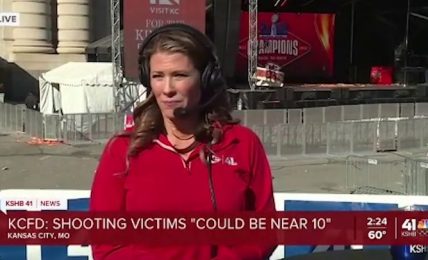Fighters with an armored vehicle during a meeting near the Ukraine-Russia border May 24. (Sergey Kozlov/EPA-EFE/Shutterstock)
The Russian fighters aligned against Moscow who launched a cross-border raid from Ukraine into the Belgorod region of Russia last week used at least four tactical vehicles originally given to Ukraine by the United States and Poland, U.S. officials said, raising questions about the unintended use of NATO-provided equipment and Kyiv’s commitments to secure materiel supplied by its supporters.
Three of the Mine-Resistant Ambush Protected vehicles, also known as MRAPs, taken into Russia by the fighters were provided by the United States and the fourth was from Poland, according to people familiar with the U.S. intelligence finding, which has not previously been reported. Those people spoke on the condition of anonymity to discuss the sensitive issue.
UP NEXT
The fighters also carried rifles made by Belgium and the Czech Republic and at least one AT-4 antitank weapon in common use among U.S. and Western troops, according to photos verified by The Washington Post.
U.S. and Western officials have insisted that Ukraine carefully track the billions of dollars’ worth of weapons that have flowed into the country. Kyiv’s backers have also largely barred Ukrainian forces from using Western weapons and equipment for attacks on Russian soil. Yet the recent raid into Russia underscores how materiel can change hands in unpredictable ways, creating oversight challenges that few in Washington and Kyiv appear willing to acknowledge. At least two MRAPs appear to have been captured by Russian forces after the operation, according to imagery examined by The Post.
The Legion of Free Russia and a second militia called the Russian Volunteer Corps (RDK) led the raid. The groups are composed of ethnic Russian fighters, including Russian citizens, who oppose Russian President Vladimir Putin and say they are working to “liberate” their homeland. Some members of the groups are known to be Russian neo-Nazis or to harbor other extremist views.
Ilya Ponomarev, political coordinator for the Legion of Free Russia, said the group was part of the International Legion, a coalition of volunteer fighters overseen and armed by the Ukrainian military. The RDK is an independent group that has said some members are in the International Legion, though the legion denied a connection to RDK, Reuters reported. The International Legion did not respond to The Post’s request for comment.
Last week’s operation took place amid widespread expectations of an imminent Ukrainian counteroffensive. The incursion was followed by an increase in other attacks on Russian territory, including drone attacks targeting Moscow and heavy shelling in the Belgorod region.
On Thursday, the RDK claimed responsibility for attacks that struck deeper into Belgorod. In a video message posted to the group’s Telegram account, fighters announced what they described as “a second phase” of operations inside Russia.
UP NEXT
The Legion of Free Russia group also released video Thursday showing what it described as attacks on Russian forces, which The Post confirmed was taken about a mile from the border in the Belgorod town of Novaya Tavolzhanka. On Friday, the group posted an image showing a tank operating in the town, and claimed to be involved in fighting there.
Border areas in Belgorod remained under attack from intense shelling, local officials said Friday, reporting at least two deaths. The wave of strikes in the region has been described by local Russian officials and journalists as the largest bombing of Russian territory since the start of Moscow’s invasion of Ukraine.
Two apartment buildings caught fire in Shebekino, the Belgorod governor, Vyacheslav Gladkov, wrote on Telegram, adding that at least 850 mortar shells had hit the region since Thursday. Thousands of residents were evacuated, according to local media, and some reacted furiously at what they described as inaction by officials.
“We were forced to abandon our house, we fled from the shelling, took shelter with friends, yesterday we wanted to return to pick up dogs, they don’t let us,” one resident of Shebekino wrote in reply to a social media posting by the governor. “What should we pensioners do?”
In Moscow, senior officials continued to project a sense of calm. The Kremlin spokesman, Dmitry Peskov, did not address the situation during his daily briefing with reporters.
When asked about the use of U.S. equipment for cross-border attacks, a State Department spokesperson said: “The United States does not encourage or enable attacks inside of Russia. We have been clear about how we don’t support the use of U.S.-made equipment being used for attacks inside of Russia, including with the Ukrainians over the past week.
“Our focus is on providing Ukraine with the equipment and training they need to retake their own sovereign territory, and we have done just that,” the official said.
A U.S. official said that “each country makes their own sovereign decisions about what assistance they provide Ukraine and what conditions they place on them.” The official noted that “many have made the same requests we have of the Ukrainians.”
A spokesperson for Ukraine’s armed forces referred questions to Kyiv’s defense intelligence agency, which did not respond to a request for comment.
Ponomarev acknowledged there are restrictions against using Western equipment in Russia, but claimed the vehicles used had a long chain of custody that made it acceptable in this instance. He said they used “trophies” that the Russians captured from Ukrainians and were subsequently recaptured and kept by the legion. Ponomarev did not provide any evidence to support his claim that the legion had recaptured Western equipment from Russian forces.
UP NEXT
RDK told The Post in a statement that it had used no foreign equipment in the operation. Yet photographs posted on RDK’s Instagram page and videos sent to The Post by the group show fighters in Belgorod holding various rifles, including the Czech-made CZ Bren and Belgium’s FN SCAR, according to Jonathan Ferguson, the keeper of firearms and artillery at Britain’s Royal Armouries who reviewed the images for The Post.
Belgium and the Czech Republic have provided arms to Ukraine, and it’s probable that is where these rifles came from, said Andrew Galer, a small-arms expert at the Janes defense intelligence firm who also reviewed the images, though he said it is possible they could have come from an intermediary country.
Bren and SCAR rifles are commonly distributed to Ukraine’s soldiers and its international volunteer fighters, according to two American volunteers serving in Ukraine.
Fighters with an FN SCAR rifle at a border crossing in Kozinka, Russia, on May 23. (Russian Volunteer Corps/Reuters)
A spokesperson for the Belgian defense ministry declined to say how many rifles it has sent to Ukraine or identify one from a photo provided by The Post. “The weapons supplied have always been passed on to the official authorities and the regular army, which is responsible for them,” a ministry spokesperson said.
The Polish and Czech Republic defense ministries declined to comment.
There have been no previous public indications of weapons agreement violations, but the episode raises questions about accountability going forward, and what the United States is willing to tolerate, said Mark Cancian, a retired Marine Corps officer and senior adviser at the Center for Strategic and International Studies. The Ukrainians “are clearly complicit here,” he said, and the United States “has indicated in [its] statements that this is contrary to policy.”
Starting May 22, photographs and footage from the incursion began to circulate, and were promoted on the social media channels of both groups. The Post independently verified a video and photograph posted by the Russian Volunteer Corps, which, along with another video, showed at least four MRAPs and an armored Humvee mounted with a .50-caliber machine gun gathered along a road in Ukraine about five miles from the Russian border. Based on the visuals alone, The Post was not able to identify where the MRAPs and Humvee were from, or if they included the vehicles analyzed by U.S. intelligence.
Soldiers can be seen with yellow armbands commonly worn by Ukrainian forces. The MRAPs and Humvee are marked with white plus signs, which Ukrainian forces have painted onto vehicles during the war. One MRAP also appears with a distinct upward arrow on its left front door.
Photographs and videos later posted on Russian social media showed at least two of the same MRAPs, both with plus signs and one with what appeared to be the same arrow on the door. One of the MRAPs later appeared in a video published by the Russian news outlet Izvestia, which reported it would now be used by the Russian military.
Francesca Ebel in London; Serhiy Morgunov in Kyiv, Ukraine; and Loveday Morris in Bratislava, Slovakia, contributed to this report.



